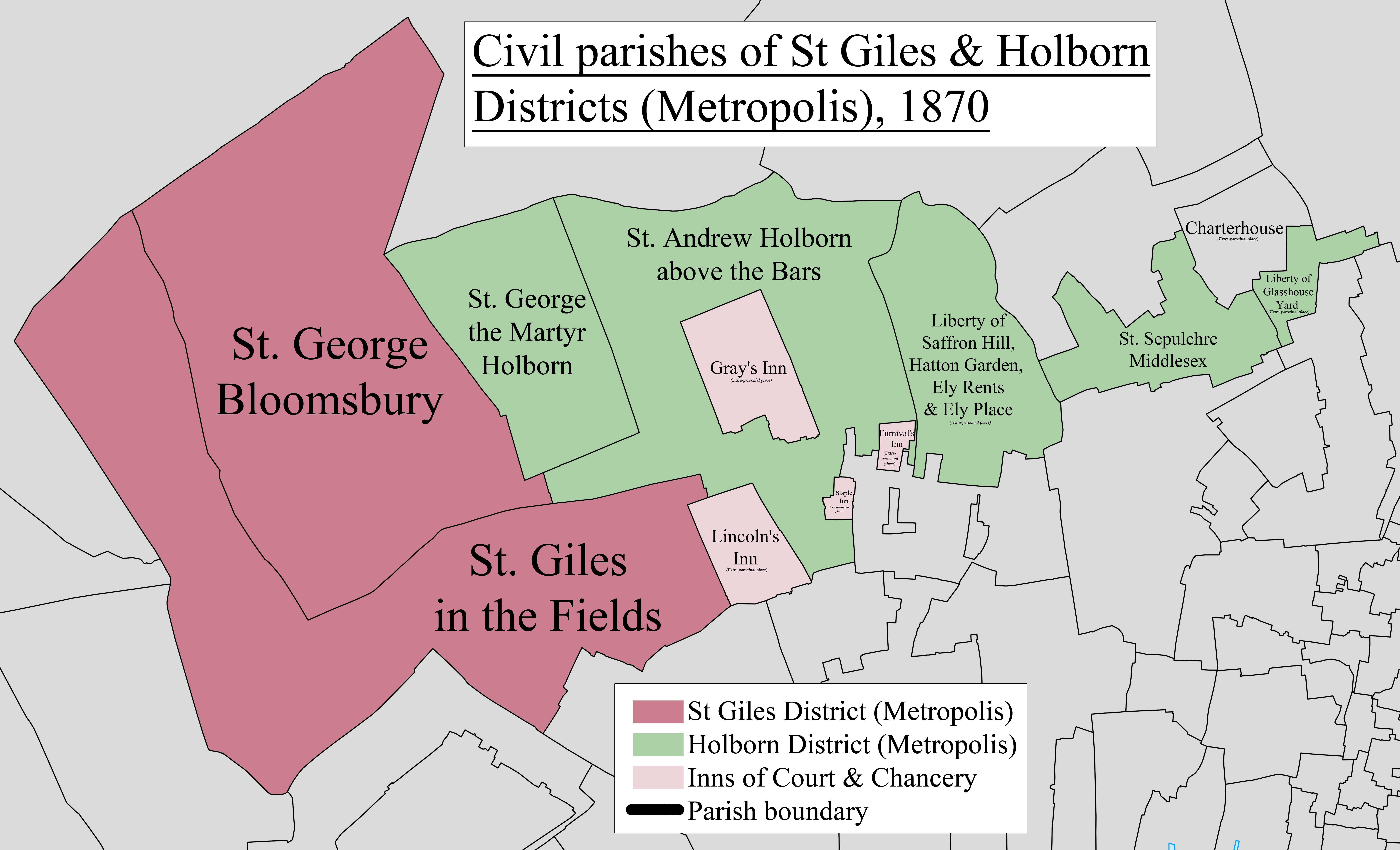St Andrew Holborn on:
[Wikipedia]
[Google]
[Amazon]
__NOTOC__
St Andrew Holborn was an ancient English parish that until 1767 was partly in the


City of London
The City of London is a city, ceremonial county and local government district that contains the historic centre and constitutes, alongside Canary Wharf, the primary central business district (CBD) of London. It constituted most of London f ...
and mainly in the county of Middlesex
Middlesex (; abbreviation: Middx) is a historic county in southeast England. Its area is almost entirely within the wider urbanised area of London and mostly within the ceremonial county of Greater London, with small sections in neighbour ...
. Its City, thus southern, part retained its former name or was sometimes officially referred to as St Andrew Holborn Below the Bars.
History


Ecclesiastical origins
Thavie's original property, which was left for his endowment of the church,Thavie's Inn
Thavie's Inn was a former Inn of Chancery, associated with Lincoln's Inn, established at Holborn, near the site of the present side street and office block still known as Thavies Inn Buildings. ''Thavie's Inn'' is one of the earliest Inns of Chan ...
became a lawyers inn and may have been the original home of Lincoln's Inn before it relocated to its present site. Lincoln's sold Thavies Inn for redevelopment in 1785. Earlier that century the small east stained-glass window was put up, representing the arms of John Thavie, Esq., who in the year 1348 "left a considerable estate towards the support of this fabric for ever" as its caption reads.
Four other new smaller parishes took over the largest green area depicted and most of Grey's Inn:
*St John the Evangelist Red Lion Square took on the south-west, eating equally into St Giles in the Fields
*St Alban, Brooke Street was rectangular parish (less small Furnivals Inn) spread from tiny Brooke Street Street to the south side of Clerkenwell Road: Reids Brewery, a Crown Court and Holborn Town Hall.
*Holy Trinity, Grays Inn Road occupied Bedford Row and the north-to-northeast quarter which thus ran from Lambs Conduit to Back Hill at the start of Hatton Garden
*Saffron Hill, Hatton Garden, Ely Rents and Ely Place
Saffron Hill, Hatton Garden, Ely Rents and Ely Place was a liberty and from 1866 to 1930 a civil parish in the metropolitan area of London, England. It was part of the ancient parish of St Andrew Holborn.
The southern boundary was the street no ...
, extra-parochial liberties covering the east were covered by a new church to St Peter.
Newcourt informs us that a public grammar school was among the adjuncts of the church. It was one of those erected by Act of Parliament in the reign of Henry VI. and, according to Maitland
Maitland is an English and Scottish surname. It arrived in Britain after the Norman conquest of 1066. There are two theories about its source. It is either a nickname reference to "bad temper/disposition" (Old French, ''Maltalent''; Anglo Norm ...
, stood on the right side of the church, and was taken down in 1737.
Civil parishes (as regards secular matters)
In 1723 the Middlesex bulk of the ecclesiastical parish was first split: its north-west corner became St George the Martyr, Queen Square (not to be confused with St George, Bloomsbury to the immediate west) and the rest remained St Andrew, Holborn. The two however recombined for civic, secular purposes in 1767 to createSt Andrew Holborn Above the Bars with St George the Martyr
St Andrew Holborn Above the Bars with St George the Martyr (also known as St Andrew Holborn Above the Bars with St George the Martyr Queen Square) was a civil parish in the metropolitan area of London, that existed from 1767 to 1930. The four In ...
; the latter at approximately the same time shed its part in the City of London to become its own parish as to lay purposes: St Andrew Holborn Below the Bars and over time under the auspices of the Farringdon Without
__NOTOC__
Farringdon Without is the most westerly Ward of the City of London, its suffix ''Without'' reflects its origin as lying beyond the City's former defensive walls. It was first established in 1394 to administer the suburbs west of Ludga ...
City Ward.
Both parishes bore quasi-civil parish (CP) areas separate from their parochial church councils. By comparison and not to be confused St Giles in the Fields and St George Bloomsbury Ancient Parish-turned Civil Parish existed 1774-1930. St Andrew Holborn Below the Bars existed abolished as a civil parish 1767-1907.F. Youngs, Local Administrative Units: Southern England (London: Royal Historical Society, 1979), p. 298.
Geography
The ancient parish included most of theHolborn
Holborn ( or ) is a district in central London, which covers the south-eastern part of the London Borough of Camden and a part ( St Andrew Holborn Below the Bars) of the Ward of Farringdon Without in the City of London.
The area has its root ...
area to the west, bordering onto St Giles in the Fields. As such it included both Lincoln's Inn and Gray's Inn
The Honourable Society of Gray's Inn, commonly known as Gray's Inn, is one of the four Inns of Court (professional associations for barristers and judges) in London. To be called to the bar in order to practise as a barrister in England and W ...
which rented pews in the church of St Andrew, Holborn, first mentioned according to Thornbury's ''Old and New London'' (1878) "given by one Gladerinus to the Dean and Chapter of St. Paul's";Walter Thornbury, 'Farringdon Street, Holborn Viaduct and St. Andrew's church', in Old and New London: Volume 2 (London, 1878), pp. 496-513. British History Online http://www.british-history.ac.uk/old-new-london/vol2/pp496-513 ccessed 20 August 2017 rebuilt to Wren's designs in 1686.
Population
;St Andrew Holborn, City of LondonReferences
{{DEFAULTSORT:Saint Andrew Holborn (parish) History of the City of London History of the London Borough of Camden Bills of mortality parishes